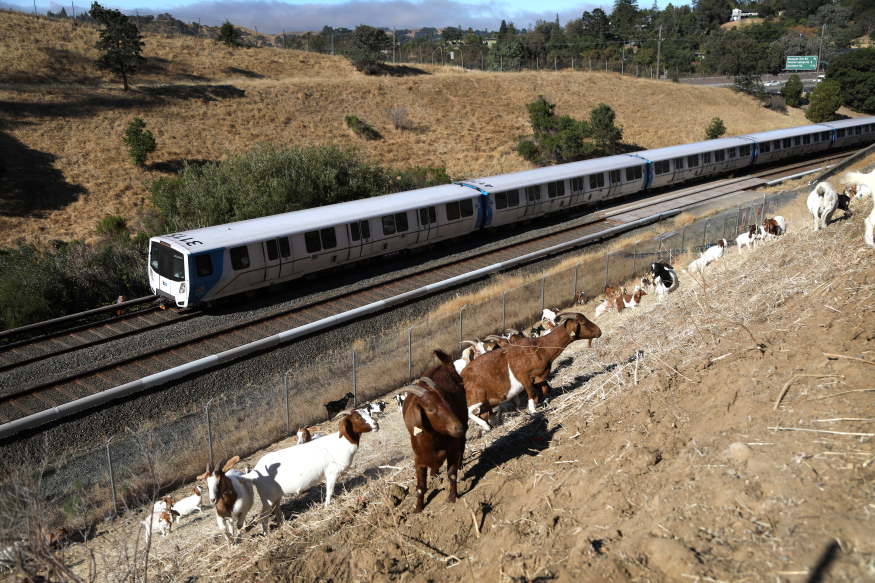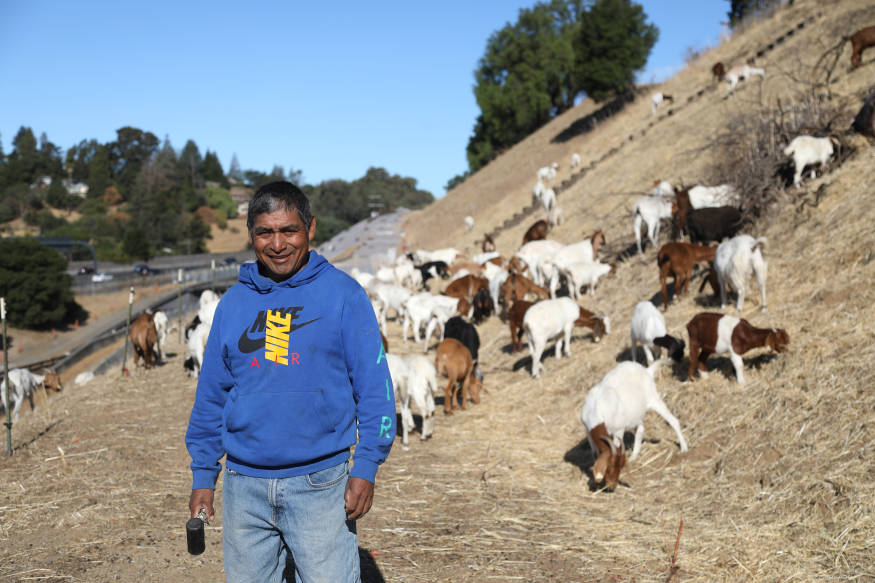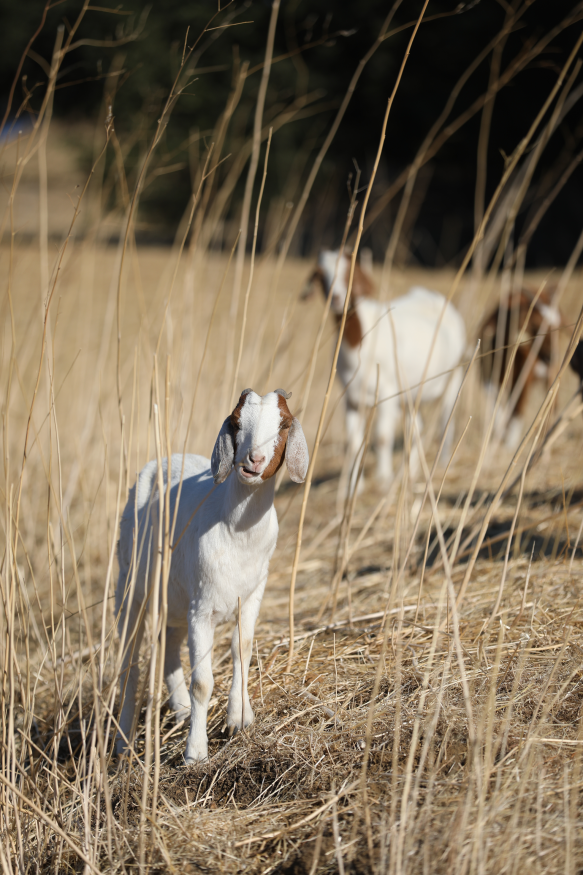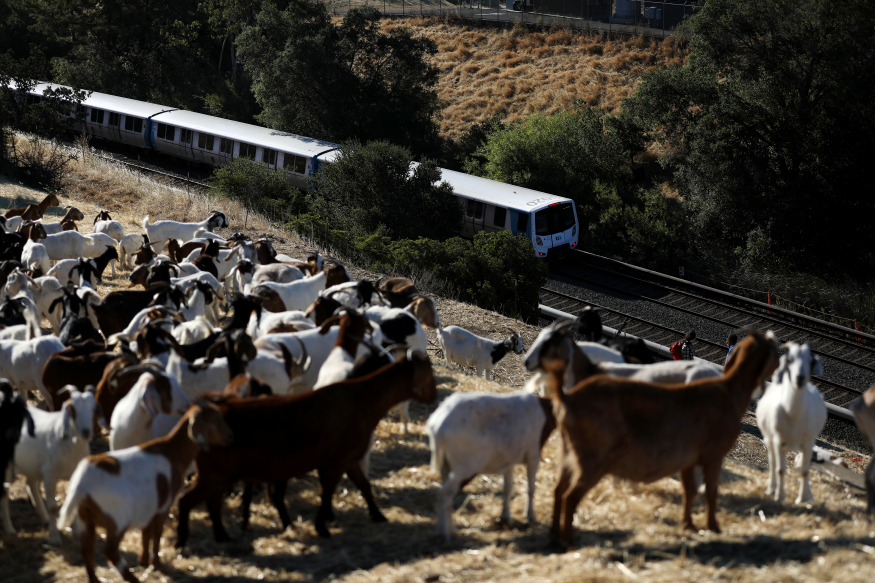Bah bah BART: Grazing goats are back and reducing fire danger on BART property

If you’re a goat, there’s one thing you really like to do: eat. And for the past few years, BART has put goats’ proclivity for munching to work to reduce fire danger on its grassy properties.
Currently, the goats can be seen grazing away on hillsides in Walnut Creek and Hayward. You might spot them from the highway or even a BART train if you keep your eyes glued to the sandy-colored hills or perk your ears to their signature “bah” sounds.
On a recent weekday, high on a hill off Camino Diablo Road in Walnut Creek, wedged between a ravioli factory and the BART tracks, a herd of goats could be seen in silhouette from the road, cresting skittishly over the hillside.
At a closer glance, the goats were in fact hard at work, eating away at the dry brush and grass below their feet as a natural means of reducing fire risk on the property. They stopped only when their herder, Zenobia Mancha, got too close or when a BART train rolled by below (the animals are protected from the tracks by an electrified fence). One kid, or baby goat, who stood just below a human’s knee height, paused to grab a drink of milk from its mother’s udders.

Herder Zenobio Mancha pictured above.
Though adorable, the goats are also highly utilitarian. According to Glen Eddy, BART’s Assistant Superintendent of Way and Facilities, Grounds Maintenance, the goats are used in place of fossil-fuel-reliant lawn mowers and other power tools, which increase the risk of sparking a fire on the drought-stricken grass and increase the safety of human workers, who once had to scale large inclines to clear the same – and very steep – hillsides. Goats are also naturally quiet creatures, thereby decreasing disruption to neighboring areas.
“Most people don’t realize just how much land and properties the District owns and maintains,” Eddy said. “Most of our rights-of-way consist of wide expanses of property to allow for a safety buffer and access to the tracks as need. Almost all are covered by wild grasses and vegetation that requires maintenance year-round.”
Originally, BART would plow or mow the grass and weeds “as much as possible,” Eddy said, “but in many locations, there just isn’t room for equipment to get in there.” Likewise, performing such work by hand was “very slow and costly,” and worker injuries “is a real concern as many of these areas are on hillsides and slopes too steep to be safely cut by hand.” Poison oak proves an issue, too, but goats eat it happily as a “dessert,” Eddy said. Several areas on BART property are also “environmentally fragile” and require less-invasive treatment.
“Goats are all-natural and pretty much go anywhere, too,” Eddy explained. “And they’re just plain fun to watch.”

BART’s goats are contracted by the Coalinga-based, family-owned business Living Systems Land Management, which owns about 4,000 goats. The animals are a cross between Spanish and Boer goats, breeds ideal for this type of work because they typically eat every edible morsel in sight. The goats also work faster than any human could, clearing about one acre each day.
Mancha stays with the goats 24 hours a day, sleeping in a trailer beside the grazing property at night. It’s essential that he’s near the goats – all 450 of them – 24/7 to ward off predators, such as mountain lions, and to make sure the goats don’t “escape by night,” Mancha said, speaking in Spanish through a translator.

“This is a safe area,” Mancha said. “But there is a risk of them wandering onto roads or into homes or onto the freeway and getting run over.”
Mancha, a Peruvian national who worked as an electrical engineer back home, has resided in the United States on an H-2A temporary agricultural worker visa for nearly three years. He intends to return to Peru – with the hope of one day settling in the U.S. permanently – at the end of this year. The herding work, he said, has enabled him to put his four children through university. Two of his children are now engineers, and two are studying accounting and law respectively.
“There’s a lot of pleasure in life,” Mancha said beaming, “But nothing like the pleasure of educating your children.”
Back home in Peru, Mancha grew up around grazing animals. His eighty-year-old father still maintains a herd of sheep, he said. The work can be challenging – and lonely – but it’s worth it for Mancha, who takes great pride in his children’s educations.
“I get lonely, yes, but what can you do,” Mancha said. “I’m pretty used to it after three years. I prefer to have a job.”

BART has used goats to mow its properties for about five years, Eddy said. They mow anywhere from five to 25 acres at each location where they’re grazed. The goats’ work typically costs BART about $800 to $1,200 an acre, and they usually work for about six weeks in the fire-prone summer months. Late-season rain events may require them to return to certain areas “for another ‘haircut,’” however, Eddy said.
BART has a history of getting creative with land and station management. Earlier this year, the transit agency began contracting a falconer and his hawk at El Cerrito del Norte Station to mitigate the station’s pigeon population. The falcon has been a hit with passengers – and has markedly improved the presence of pigeons on the property.